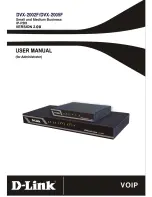
System Password - PC Programming—User Level
System Password - PC Programming—Administrator Level
System Password - PC Programming—Installer Level
PT Programming Manual References
Feature Manual References
4.1.6 DID (Direct Inward Dialing)
4.1.7 DIL (Direct In Line)
13.1.3 Password Security
13.1.7 PDN (Primary Directory Number)/SDN (Secondary Directory
Number) Extension
Description
Primary Directory Number (PDN) buttons and Secondary Directory Number (SDN) buttons are ideal for use
between bosses and secretaries. When a call (intercom or CO) arrives at a PDN button on the boss’s extension,
the call will ring and the LED of the SDN button will flash at the secretary’s extension as well, indicating that
an incoming call is arriving at the boss’s extension. In addition, caller information (e.g., Caller ID) of the incoming
call will appear on the secretary’s extension. The secretary can answer the call for the boss by simply pressing
the SDN button. Delayed ringing can be set for a PDN or SDN button.
A secretary can hold a call answered on the SDN button, and the boss can retrieve the held call simply by
pressing the PDN button, like when answering a call with an S-CO button. In addition, a secretary can transfer
calls from an SDN button or other button (e.g., S-CO button) to the boss’s extension with a simple operation,
like when using a DSS button.
An extension can have several SDN buttons, each registered to a different boss’s extension. However, only
one SDN button can be registered for a single boss at each extension. An extension can have up to eight PDN
buttons. PDN buttons can simplify the use of an extension because both intercom and CO line calls can be
made and received at a PDN button.
Making Calls with an SDN Button
When Standard SDN Key mode is assigned to an SDN extension (secretary) through COS programming, SDN
extensions (secretaries) can make calls for PDN extensions (bosses) on the SDN button. For example, a boss
can ask a secretary to make a call and put the call on hold, after which, the boss can retrieve the held call.
Through COS programming, it is possible to allow an SDN extension to make calls using the COS of the PDN
extension. All other settings that are available when using the Walking COS feature are also applied (
®
SDN Direct Dial
An SDN extension can call a PDN extension or transfer a call to a PDN extension using an SDN button.
In this case:
–
Only the PDN extension rings (i.e., other SDN extensions do not ring).
–
The delayed ringing and DND settings of the PDN extension are ignored.
Document Version 2013-05
Feature Manual
225
13.1.7 PDN (Primary Directory Number)/SDN (Secondary Directory Number) Extension
Summary of Contents for KX-NCP500
Page 13: ...Section 1 Features and Configurations A Document Version 2013 05 Feature Manual 13...
Page 27: ...Section 2 Features and Configurations B Document Version 2013 05 Feature Manual 27...
Page 30: ...30 Feature Manual Document Version 2013 05 2 1 1 BGM Background Music...
Page 31: ...Section 3 Features and Configurations C Document Version 2013 05 Feature Manual 31...
Page 75: ...Section 4 Features and Configurations D Document Version 2013 05 Feature Manual 75...
Page 100: ...100 Feature Manual Document Version 2013 05 4 1 12 Doorphone Call...
Page 101: ...Section 5 Features and Configurations E Document Version 2013 05 Feature Manual 101...
Page 112: ...112 Feature Manual Document Version 2013 05 5 1 9 External Sensor...
Page 113: ...Section 6 Features and Configurations F Document Version 2013 05 Feature Manual 113...
Page 135: ...Section 7 Features and Configurations G Document Version 2013 05 Feature Manual 135...
Page 140: ...140 Feature Manual Document Version 2013 05 7 1 1 GROUP FEATURES...
Page 141: ...Section 8 Features and Configurations H Document Version 2013 05 Feature Manual 141...
Page 149: ...Section 9 Features and Configurations I Document Version 2013 05 Feature Manual 149...
Page 185: ...Section 10 Features and Configurations L Document Version 2013 05 Feature Manual 185...
Page 193: ...Section 11 Features and Configurations M Document Version 2013 05 Feature Manual 193...
Page 204: ...204 Feature Manual Document Version 2013 05 11 1 5 Mute...
Page 205: ...Section 12 Features and Configurations O Document Version 2013 05 Feature Manual 205...
Page 212: ...212 Feature Manual Document Version 2013 05 12 1 5 Operator Features...
Page 213: ...Section 13 Features and Configurations P Document Version 2013 05 Feature Manual 213...
Page 296: ...296 Feature Manual Document Version 2013 05 13 1 32 PT Programming...
Page 297: ...Section 14 Features and Configurations Q Document Version 2013 05 Feature Manual 297...
Page 301: ...Section 15 Features and Configurations R Document Version 2013 05 Feature Manual 301...
Page 307: ...Section 16 Features and Configurations S Document Version 2013 05 Feature Manual 307...
Page 332: ...332 Feature Manual Document Version 2013 05 16 1 10 Syslog Record Management...
Page 333: ...Section 17 Features and Configurations T Document Version 2013 05 Feature Manual 333...
Page 354: ...354 Feature Manual Document Version 2013 05 17 1 6 TRS Toll Restriction...
Page 355: ...Section 18 Features and Configurations U Document Version 2013 05 Feature Manual 355...
Page 357: ...Section 19 Features and Configurations V Document Version 2013 05 Feature Manual 357...
Page 379: ...Section 20 Features and Configurations W Document Version 2013 05 Feature Manual 379...
Page 388: ...388 Feature Manual Document Version 2013 05 20 1 5 Wireless XDP Parallel Mode...
Page 389: ...Section 21 Appendix Document Version 2013 05 Feature Manual 389...
Page 415: ...Index Document Version 2013 05 Feature Manual 415...
Page 421: ...Document Version 2013 05 Feature Manual 421 Notes...



































